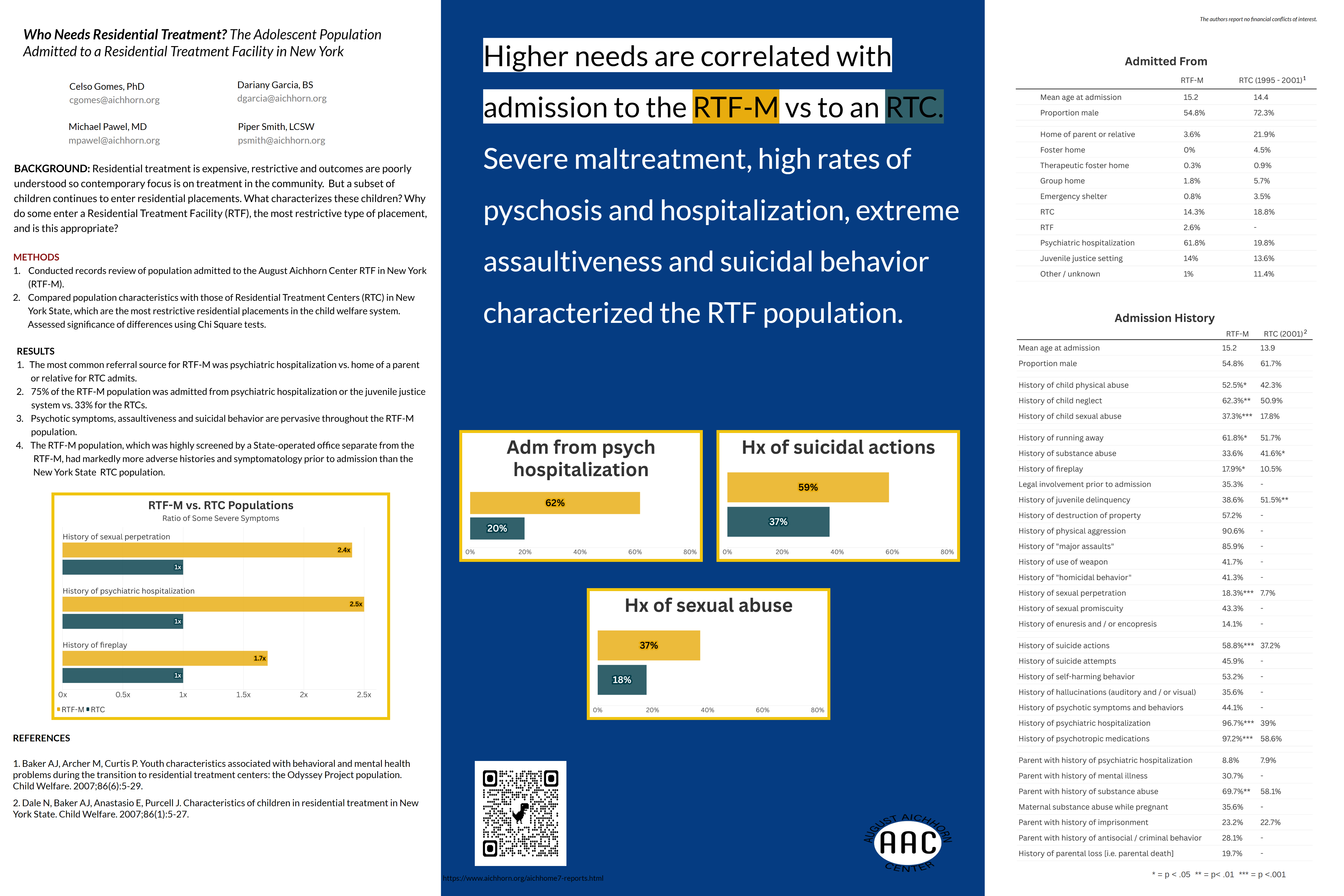
THE
AUGUST AICHHORN CENTER
for
ADOLESCENT RESIDENTIAL CARE, Inc.
The range and severity of symptoms that lead to residential placement of adolescents is very wide. While direct comparisons are difficult, we compared the basic demographics, primary referral diagnoses, and the number of psychiatric diagnoses in the referral material, of individuals admitted to the Aichhorn RTF-Manhattan (RTF-M) with published reports on these variables from several other residential programs.
All referrals to the RTF-M were screened and approved by a State-run inter-agency "Pre-Admission Certification Committee" which determined whether they required such a high level of care. Not surprisingly, therefore, the RTF-M population included markedly higher indices of severity in several categories than the much larger group of youngsters placed in congregate foster care "Residential Treatment Centers" (RTCs).
A poster exhibited at the American Academy of Child and Adolescent Psychiatry annual conference of 2025 highlights the differences in symptom severity between youngsters admitted to foster care Residential Treatment Centers in New York State and those admitted to the RTF-M. (To enlarge click here. )

The items below illustrate additional comparisons between the RTF-M population and those of various other programs.
The following chart compares some demographic characteristics of the population admitted to the RTF-M with those of a group of psychiatric residential treatment facilities in North Carolina and a small experimental program for very high-needs children in the Texas foster care population. It is clear that the North Carolina population is quite distinct from those of the Texas and the Aichhorn programs, both of which operated with a "no reject, no eject" admission policy. The North Carolina group includes some much younger children, with a much lower rate of prior psychiatric hospitalization. The proportion of non-white children in the RTF-M group is considerably larger than in either the North Carolina or the Texas programs. (Data not available for the Solnit Children's Center.)
The primary psychiatric diagnoses in the referral material of youngsters admitted to the programs also showed considerable variation. The RTF-M referrals skewed toward more severe diagnostic categories of schizophrenia and bipolar disorder. The North Carolina programs emphasized disruptive behavior and bipolar disorders. The Solnit program handled primarily mood disorders and PTSD. (Primary referral data not available for Texas Exceptional Care Pilot; missing in 33 RTF-M records.)
The number of referral diagnoses tended to be higher in the RTF-M and Texas programs than in the North Carolina program. (Texas program only reported data for "more than three diagnoses"--15 of 27 patients. Data not available for Solnit Children's Center; data not available for 44 of 392 referrals to the RTF-M.)
The data above is summarized in the following table:
References:
Armour, Marilyn P., and James Schwab. Characteristics of Difficult-to-Place Youth in State Custody:
A Profile of the Exceptional Care Pilot Project Population.
Child Welfare 86, no. 3 (2007): 71 – 96.
Bruton, J, A Blackmon, C Wiford, B Burns, and L Maultsby. Evaluation of Psychiatric Residential
Treatment Facility Use by North Carolina Children for Fiscal Years 2009‐2011.
Access September 26, 2017.
2012. https://web.archive.org/web/20160309001742/http://serp.mc.duke.edu/PDF/PRTF_Evaluation_Report.pdf.
Wudarsky, Marianne, Janelle Arias, Alton Allen, Bhagya Reddy, and Muhammad Waqar Azeem.
Attachment, Development & Trauma Informed Care for Female Adolescents in Unlocked
Psychiatric Residential Treatment Facilities (PRTFs) in Connecticut, USA.
Unpublished, 2014.
https://doi.org/10.13140/2.1.1834.5286.
[updated 10/15/2025]